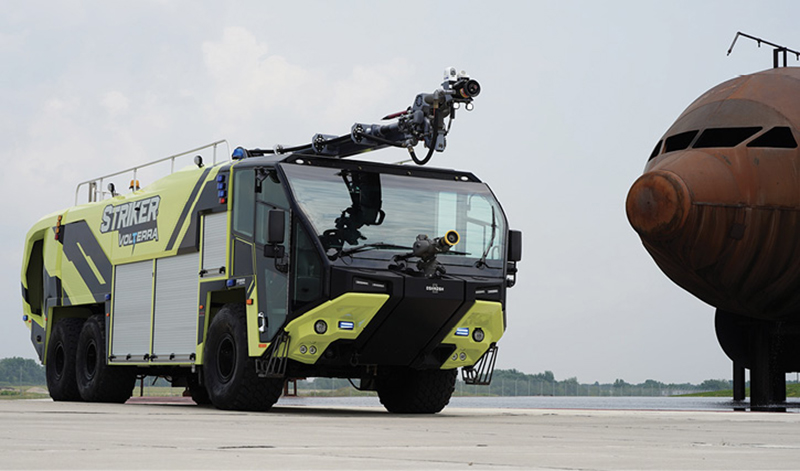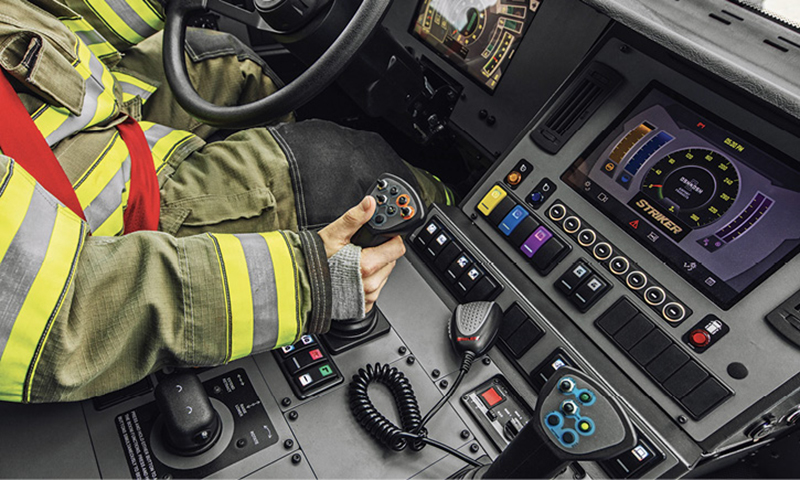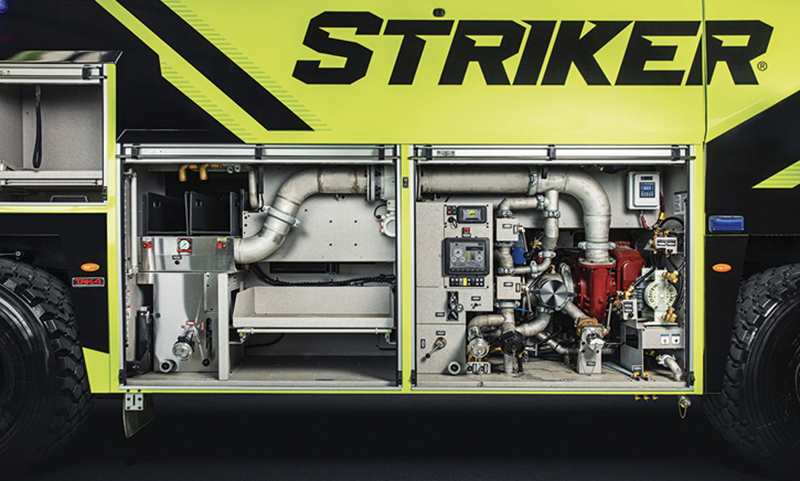
Aircraft rescue and firefighting (ARFF) firefighters now have an electric option in an ARFF truck with the introduction of the Oshkosh Striker® Volterra™.
It’s a close cousin to Pierce Manufacturing’s Volterra Type 1 pumper but with a Scania engine; onboard batteries; and an electro-mechanical transmission that deliver a lot more zip to the vehicle’s acceleration capabilities, even while negotiating 90 degree turns on taxiways to get to the location of an incident quickly and safely.
Jack Bermingham, business unit director of airport products for Oshkosh Airport Products LLC, says Oshkosh developed the Striker Volterra hybrid electric vehicle (HEV) ARFF truck, which is being offered on Oshkosh’s 4×4 and 6×6 chassis platforms, as a vehicle that’s engineered to channel mechanical power and battery power to maximize driving and pumping performance while reducing fuel consumption and emissions.
Electric Apparatus Make Their Way into the Fire Service
ARFF Units at Airports Vary in Size Depending on Aircraft and Airports Being Protected
ARFF Leaders: Are We Training Them for Failure?
Small-Size ARFF Trucks Often Protect Smaller and Midsize Airfields
ARFF Service: a Relationship Business
New and Refined ARFF Truck Designs

1 Oshkosh Airport Products LLC has developed the Striker Volterra hybrid electric vehicle ARFF truck, shown here in a 6×6 version.(Photos courtesy of Oshkosh Airport Products LLC.)

2 Pumping operations on the Striker Volterra 6×6 are done through a 2,000-gpm water pump, powered by a Scania diesel engine.
“Users will still enjoy legacy features found on the Striker ARFF vehicle while gaining the benefits of the Striker Volterra technology,” he points out. “Operation of the vehicle is consistent with current Striker ARFF models, so no additional training is necessary, which eases operations and fleet integration.”
Bermingham adds that the Striker Volterra hybrid electric ARFF truck has been fully tested and is compliant with National Fire Protection Association (NFPA) 414, Standard for Aircraft Rescue and Fire-Fighting Vehicles, and International Civil Aviation Organization (ICAO) standards.
He says the Striker Volterra has an Oshkosh-patented hybrid electric drive train that features an electro-mechanical, infinitely variable transmission, which allows zero emissions operation when powered by the integrated onboard batteries. It can also be coupled to the internal combustion engine through an Oshkosh power divider to provide continuous and uninterrupted power to the pumping system or the drive system.
“The two onboard high-voltage batteries are located midship in the center of the apparatus, arranged vertically behind the vehicle’s water tank and above the rear axle,” Bermingham says. “They can be coupled to the vehicle’s 550-horsepower (hp) Scania DC13 diesel engine through the electro-mechanical transmission, which allows the operator to use just the batteries, or the Scania diesel engine, or both simultaneously.”
An advantage of coupling battery power with a traditional diesel engine is faster acceleration, Bermingham maintains. “The Striker Volterra is capable of achieving 28 percent improved acceleration when fully loaded, which results in a quickened response time,” he says. “The Striker Volterra will go from zero to 50 miles per hour (mph) in 25 seconds.”
Other advantages to the electric power technology include zero emission driving during entry and exit of the fire station when using onboard energy storage, Bermingham points out, and idle reduction for up to one hour of zero emissions. He adds that the rig has Plug-In Hybrid Electric Vehicle (PHEV) options for further electric driving capabilities.
The Scania diesel engine still powers the water pump on the Striker Volterra ARFF truck, Bermingham observes. “Reliability and up-time are key to our customers,” he says. “An aviation incident can happen at any point in time, and having an internal combustion engine allows us to retain the NFPA pumping requirement that a battery would not be able to achieve.”
Bermingham notes the Striker Volterra 6×6 vehicle configuration has a modular cab design with a center steer driving position, seating capacity for five persons, and TAK-4® all-wheel independent suspension and carries a 50-foot Snozzle® HRET (high reach extendable turret) with an Oshkosh K-Factor™ piercing tip alignment system.

3 The 50-foot Snozzle HRET is available on both the 6×6 and 4×4 Striker Volterra models.
It has a 2,000-gpm pump, a 3,170-gallon water tank, a 444-gallon foam tank, a 550-pound dry chemical powder system, and 420 pounds of Halotron or clean agent. The Striker Volterra 4×4 ARFF truck has the same drivetrain as the 6×6 and a 1,585-gpm water pump, 220-gallon foam tank, options for a 50-foot Snozzle, 550 pounds of dry chemical, and 420 pounds of Halotron or clean agent, Bermingham adds.
Electric vehicle (EV) driving activates on startup without any user input when the Striker Volterra ARFF truck rolls out of the fire station, Bermingham says. On reentry, the vehicle can be seamlessly shifted to EV mode, which uses only the onboard batteries to power the drivetrain to lower firefighter exposure to exhaust emissions and noise. When operating in standby mode, the vehicle operates at zero emissions by using its onboard batteries, he notes, and the diesel engine will start as needed to maintain battery readiness.

4 The interior of the cab on the 6×6 Striker Volterra.

5 The Striker Volterra’s 550-hp Scania DC13 diesel engine, coupled with the rig’s batteries through an electro-mechanical transmission, has shown a 28 percent improvement in acceleration when the truck is fully loaded.
When driving, the Striker Volterra automatically shifts to Hybrid Mode as needed for acceleration and to maintain the batteries for maximum readiness. The vehicle’s design, Bermingham says, has the Scania diesel engine and the batteries working together to maximize performance and response time. The Striker Volterra also features regenerative braking that increases efficiency and reduces brake wear by converting the vehicle’s kinetic energy to electricity, recharging the batteries, and reducing brake temperature and wear.
When operating in pump and roll, the rig uses both the engine and the battery, with the advanced power train continuously powering the pump and the driver’s input being applied to the vehicle’s motion. In stationary pumping, the Scania diesel engine powers the water pump and the vehicle’s Command Zone control system optimizes engine revolutions per minute (rpm) based on the pump’s requirements to reduce emissions and noise.
Bermingham notes that the Striker Volterra hybrid ARFF truck was taken on a road tour late last year of many airports across the United States and this spring was taken on a tour of European airports. “We’ve put the vehicle through its paces internally, with many years of internal development and testing to make sure the product is right,” Bermingham says. “We took the Striker Volterra on tour because we wanted feedback from ARFF truck users and received a great many good comments about the vehicle.”
ALAN M. PETRILLO is a Tucson, Arizona-based journalist, the author of three novels and five nonfiction books, and a member of the Fire Apparatus & Emergency Equipment Editorial Advisory Board. He served 22 years with the Verdoy (NY) Fire Department, including in the position of chief.

